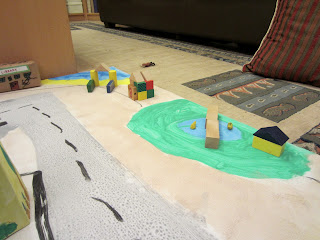"Let your vision be world-embracing, rather than confined to your own self."
To give the children a sense of the vastness and diversity of the world beyond our daily lives, we watched parts of documentaries focusing on other cultures and global experiences. We watched some of an episode from the incredible "Human Planet" series and parts of the stunning documentary "Home", ( available in its entirety on Youtube). ("Home" can be a bit intense for some students this age, so it's good to explain the narration.)
A class or two after watching Home, Melody brought a drawing she had done. On one side of the paper she drew things that all people really need and should have: food, clothes, trees, rain, housing, sight, the sun. And on the other side she wrote the statement: "The world is very important" and showed what people don't really need --televisions, computers... I don't recall what the other two "unnecessary" material objects that she drew are, but I thought it was so wonderful that her mind was absorbed by these subjects and she was moved to put her ideas down and share them with us...



In our discussions we also talked about how this quotation can include reaching out and serving members of our own communities. For the arts and crafts part of our class, we created a community out of paper, tea boxes and blocks. The idea was to create a community which included a House of Worship and its dependencies, but this had to be modified and the project took on a life of its own.
We took a short walk in the neighborhood and wrote down what sort of things exist in a community. The kids generated a good-sized list and then got to planning what they would include in their model.


They consulted on the layout of the community and painted the poster-board foundation. They also painted templates for paper houses and buildings which can be found here.


Here are the various buildings they included in the community and (in their own words) the experiences a person would have when visiting -- notice how child-friendly the community is:
Hotel
The people at the hotel would make the hotel like your home. They would make you feel like you're family. They would give you good service.
Library
The library is quiet and they always love children coming. They do not shout at children, but quietly tell the children not to run.
Hospital
At the hospital they take care of you when you're sick and are very, very kind. If you need surgery the doctor comes to calm you down and help you feel better.
Elderly Home
The elderly people always like children coming. The children are very polite and give the elderly pictures they've drawn. The older people teach the children how to do things.
Baha'i Centre
At the Baha'i Centre they sing Baha'i songs and say prayers. They do Ruhi classes, Junior Youth activities and children's classes. (Teacher-led addition: there are also Firesides and Nineteen Day Feasts. At Feast you say prayers and have consultations about the community.)
Children's Museum
At the children's museum the ticket taker is always pleased to see children and has a big bowl of lollipops that she gives away. She gives a big discount. At the museum there are things to build and experiments. There's an indoor playground with climbing webs and you can play tag and hide- and- seek.
Shops
There are different shops, and sometimes the owners will give away something for free to be nice. The shop owners are loving, kind and caring. They give some of the money they make to the school for orphans and the elderly.
School for Orphans
At school the children learn how to treat each other kindly and lovingly and learn how to read books. They also learn math, science, languages, and about the Baha'i Faith.
The community also included a park and beach
and a university, located next to the school for orphans.
Here are some aerial shots of the community captured by our Channel 9 News helicopter.







































